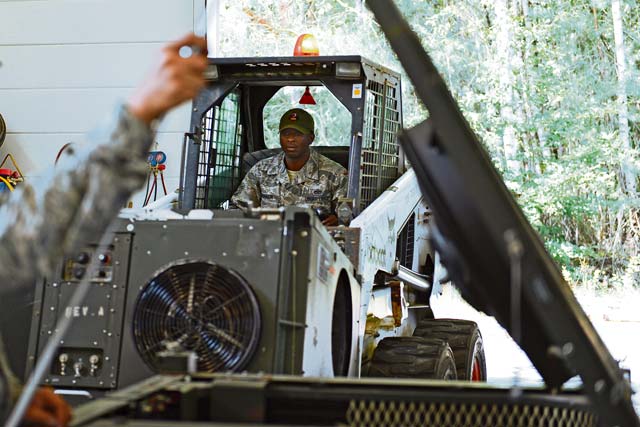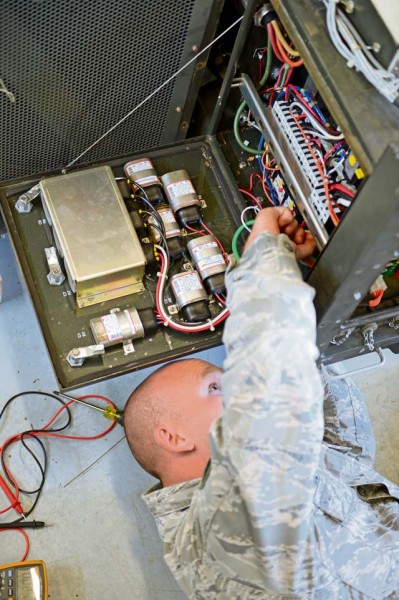
Staff Sgt. Patrick Robinson, 435th Construction and Training Squadron heating ventilation air condition instructor, moves a field-deployable, environmental control unit during a seven-day heating, ventilation and air conditioning course on Ramstein Air Base, Germany, Aug. 6, 2014. The FDECU is a five-ton air conditioning unit used to heat and cool a variety of military shelter systems such as personnel tents and communications facilities at deployed locations.
The 435th CTS teaches monthly seven-day contingency HVAC training for deploying Airmen from all over the Air Force. From keeping computers from overheating, to ensuring food doesn’t spoil, temperature regulation is a vital part of Air Force mission success.
Each day starts off with a classroom session going over the fundamentals to ensure the Airmen are comfortable with the material.
“I already knew the material we went over today, but this course just makes me more confident when in the field,” said Senior Airman Robert Stocks, 52nd Civil Engineer Squadron HVAC journeyman, from Spangdahlem Air Base, Germany.
After some time in the classroom each day, the Airmen start the hands-on portion of the training. They take apart, inspect and troubleshoot field-deployable, environmental control units. The FDECUs are five-ton HVAC units that are used to heat or cool a variety of shelter systems such as personnel tents and communications facilities in deployed locations and cost around $10,800.
Stocks said he felt more confident about being able to fix the FDECU after the hands-on training.

Staff Sgt. Larry Hampp, 435th Construction and Training Squadron heating ventilation air condition instructor, works on a field-deployable, environmental control unit during a seven-day heating, ventilation and air conditioning course on Ramstein Air Base, Germany, Aug. 6, 2014. The FDECU is used to control the temperature of the facilities in deployed locations and costs around $10, 800.
“I’m directly involved in helping train hundreds of members that come through this seven-day course … giving them [the] knowledge to troubleshoot and fix contingency operation equipment downrange,” said Staff Sgt. Patrick Robinson, 435th CTS HVAC contingency silver flag instructor. “That’s my favorite part of my job.”
Robinson said he feels he has a positive impact in helping sharpen Airmen’s abilities.
“Being an instructor and seeing people’s face light up when they learn something new or hear their positive feedback at the end of the course is a satisfying feeling,” said Robinson. “The exciting part of my job is seeing the result of my instruction. Two years ago I trained one of my students, and now he’s here right alongside of me instructing as well. That gave me the feeling that I inspired him somehow to come on the mission and help out other members of the Air Force.”
According to Robinson, HVAC affects many people and helps the overall mission of the Air Force in multiple ways.
“If you’re deployed to Africa, Afghanistan or many different countries, you’re directly involved in improving the quality of life of a lot of Airmen,” said Robinson.
Robinson also said, that if he had to get others to join him in his career field, he would emphasize that his role, as instructor, touches lives.
HVAC plays a significant part in the AF mission. Regulating the temperature of facilities in deployed locations, properly storing food and overall climate control is the work of the 435th CTS HVAC team.







